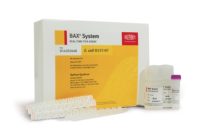The U.S. Department of Agriculture’s Agricultural Research Service (USDA-ARS) and PathoGenetix have signed an agreement to evaluate the company’s Genome Sequence Scanning (GSS) technology for use in identifying strains of Shigatoxin-producing E. coli (STECs) and Salmonella enterica, two types of pathogens frequently implicated in foodborne illness outbreaks. The ability to quickly and accurately identify these pathogens, particularly in their most virulent forms, can have significant public health and financial impact for consumers, farmers and ranchers, and the agricultural and food industries.
Under the agreement, USDA-ARS will provide PathoGenetix with genetic information and bacterial strains of E. coli and Salmonella. USDA-ARS and PathoGenetix researchers will analyze the strains, both as isolates and in mixed cultures, using PathoGenetix’s GSS technology, currently in development for commercial use as the RESOLUTION™ Microbial Genotyping System. Results of the joint analysis will assist USDA-ARS in evaluation of the RESOLUTION System as a platform for rapidly identifying pathogenic Salmonella and E. coli in food samples.
“As we work to deliver a fully automated RESOLUTION System for rapid and effective pathogen strain typing next year, we are pleased to partner with USDA-ARS to demonstrate the speed and effectiveness of the GSS technology, particularly in differentiating the most virulent pathogens that pose the greatest challenges to food safety and public health investigations,” said Ann Merrifield, CEO of PathoGenetix.
Shiga-toxigenic Escherichia coli (STEC) and Salmonella enterica represent an important U.S. public health concern, causing an estimated 1.2 million cases of foodborne illness each year. E. coli O157:H7, the most common of the virulent STECs, has been implicated in multiple foodborne illness outbreaks, and six additional STEC serogroups are now considered adulterants in certain beef products. Unlike STEC O157:H7, however, the “Big 6” virulent strains are not easily distinguished using available molecular testing methods. Of the more than 2,500 identified strains of Salmonella enterica, 1,700 of them are classified as human pathogens belonging to subspecies S. enterica I. Just 20 of these serotypes are responsible for more than 70% of the illnesses caused by S. enterica subspecies I. Clearly, there is a need to be able to rapidly and cost-effectively identify these more virulent strains when they are present in food products.
PathoGenetix’s GSS technology identifies microbial DNA from complex mixtures or from isolates, and automates the process from sample preparation through data analysis to provide actionable information in five hours. Because GSS scans microbial DNA directly from a mixed culture and does not require a pure culture, it can reduce the time, complexity, skill and cost required for molecular identification and strain typing. The strain type information provided by GSS is comparable to pulsed field gel electrophoresis (PFGE), the current standard for pathogen typing in foodborne outbreak investigation and response. As a result, GSS may enable quicker decisions affecting food safety and public health.
In addition to demonstrating use of GSS to identify pathogens such as Salmonella in enriched food samples in five hours, PathoGenetix research also has shown the use of the technology to differentiate virulent Shiga toxin-producing E. coli. As a result, the RESOLUTION System also could be used as a confirmatory method for “Big 6” STEC screening assays, and potentially reduce the loss of product associated with false positive results from current STEC screening tests.


